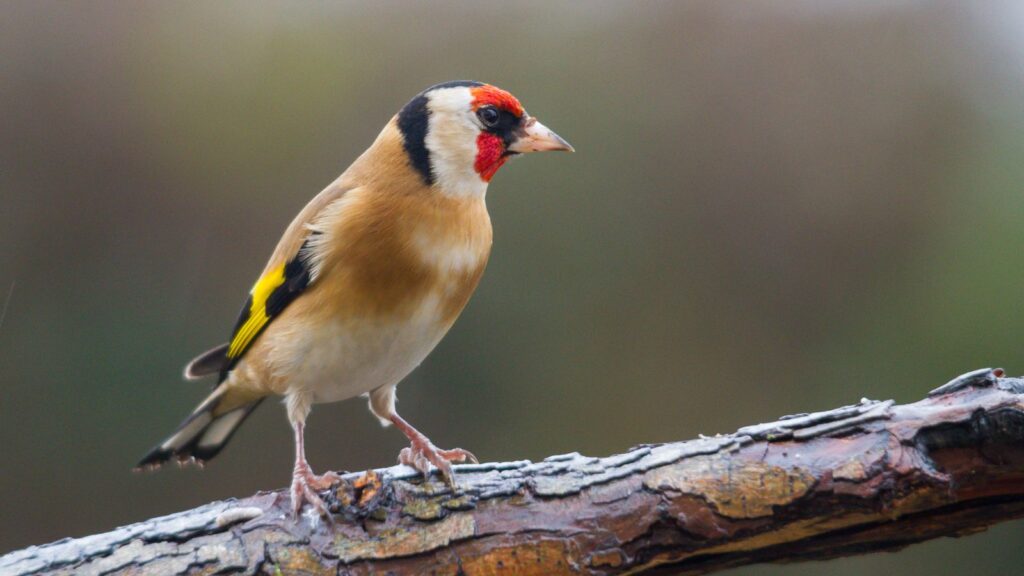Florida is known for its crystal beaches and thriving nightlife, but it also has a plethora of lovely bird species! There are twelve finches you can snap shots of in Florida for your next travel album.
Finches remain one of the most charming passerine birds, immediately identifiable by their conical beaks. Their variety of colors and patterns are fun to spot from the comfort of your home or out on the open trail.
To make sure you spot them all, I have a list of the top twelve finches in Florida below. I’ll break down their appearance, share fun facts, and equip you with prime birdwatching tips!
Purple Finch

- Scientific Name: Haemorhous purpureus purpureus
- Length: 15.2 cm
- Weight: 34 grams
- Wingspan: 25.4 cm
What better way to start off a list of Floridian finches than with one of the most iconic types? This finch has a somewhat misleading name that you’ll spot very quickly.
Appearance
The male purple finch boasts blushy reddish heads and chests rather than purple. Their forked tails and short wings give them a striking silhouette.
The female purple finch has softer colors with a light brown body, white stomach, and white lines around their eyes.
Range
Expect to find purple finches soaring around Florida’s skies during the winter. Their habitat is varied, so you can find them roaming forests as well as wide fields.
This kind of finch is just begging for a snapshot, so make sure to bring your best camera to capture their rosy sheen.
Diet
While house finches often compete with purple finches for space, you still won’t have a hard time finding them. Purple finches regularly browse feeders for an easy meal, so invite them over with piles of millet and sunflower seeds.
They’ll also munch on the occasional caterpillar, berry, or beetle.
Birdsong
Expect to hear a cheerful warble that rises and dips with identifiable patterns.
Fun Fact
With such a lovely appearance, it’s not surprising to see that the purple finch is the official state bird of New Hampshire.
Indigo Bunting
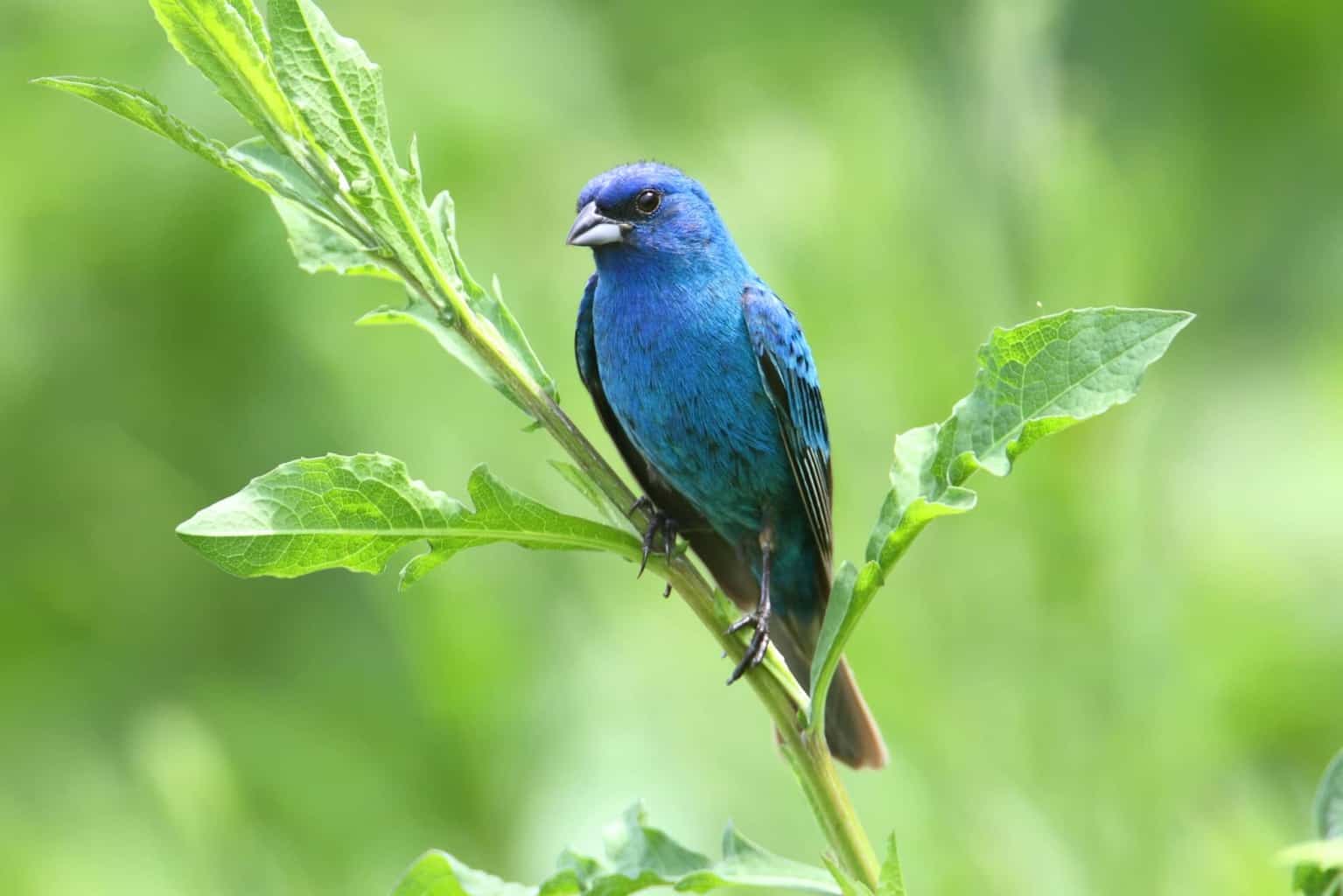
- Scientific Name: Passerina cyanea
- Length: 11.5 cm to 13 cm
- Weight: 14.5 g
- Wingspan: 23 to 25 cm
This finch’s beautiful plumage is a must-see for fans of swallows and blue jays.
Appearance
Not to be outdone, the male indigo bunting boasts royal blue coloration that pops against its natural habitat. Their wings trickle into a gray green and their beaks are a bright pop of yellow.
Female indigo buntings look similar to juveniles with light brown and dark brown coloration and faintly striped wings.
Range
These finches will roam Northern Florida during the breeding season, much preferring open fields and overgrown shrubs.
Diet
Insects and seeds are their favorite meals, though you can attract some to your feeder with Nyjer seeds.
Birdcall
When keeping an ear out for one of these beauties, remember they have a rapid-fire two-note call.
Fun Fact
If you’re a fan of bird photography, keep in mind indigo buntings’s feathers only reflect those brilliant colors in bright light. Low light in the evening or early morning dulls their coloration and makes them difficult to spot.
Painted Bunting
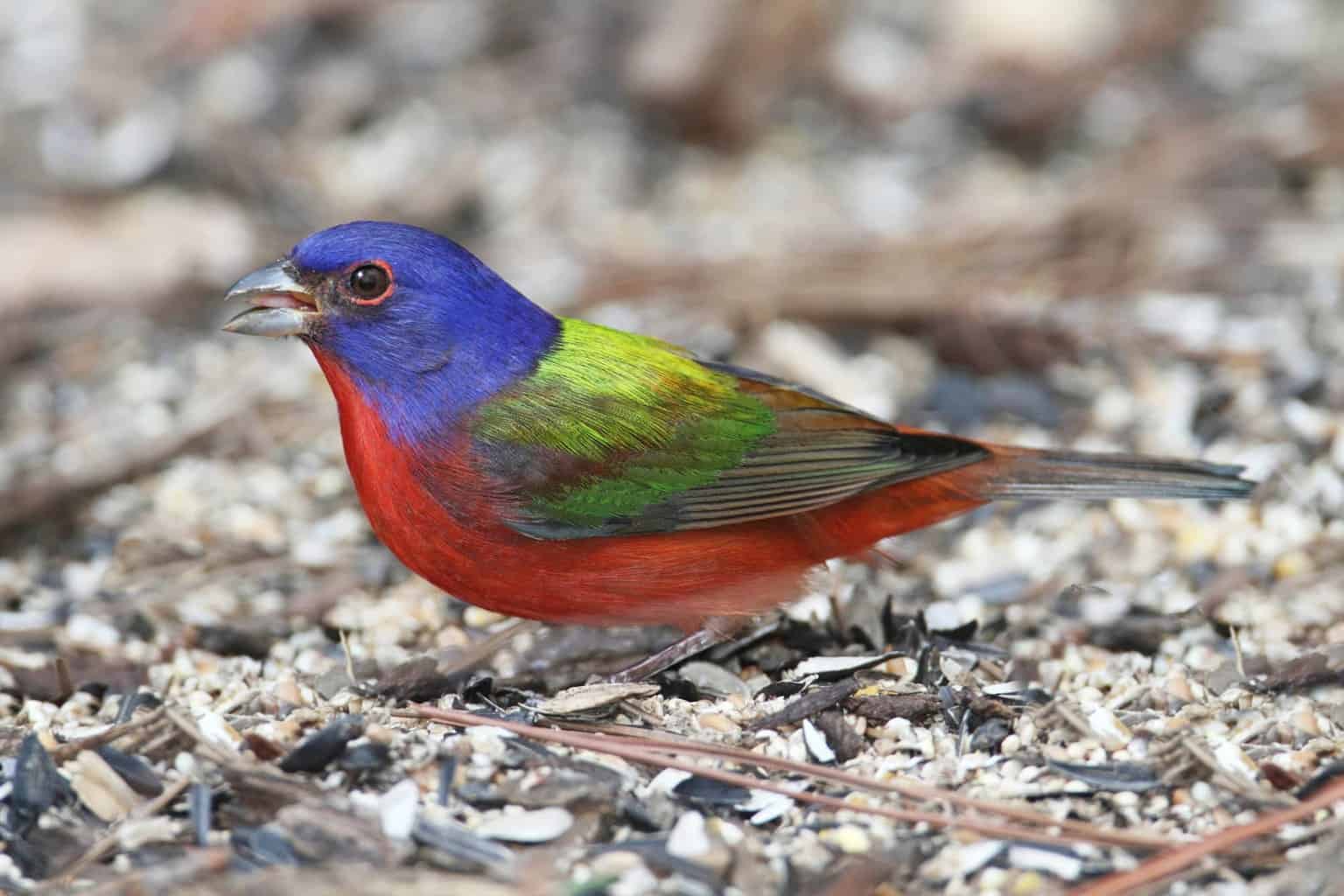
- Scientific Name: Passerina ciris
- Length: 12 cm to 14 cm
- Weight: 13 to 19 grams
- Wingspan: 21 to 23 cm
It’s only a matter of time until you hear about the legendary painted bunting. Its stunning appearance earned the French title ‘nonpareil’ which means ‘without equal’.
Appearance
The painted bunting is a rather unique finch, as the males almost appear parrot-like in their coloration. They boast blue heads, red chests, and green wings with dark tips.
Female painted buntings are rather stunning, too, with charming yellow-green coloration all over with hints of blue-gray on the wings.
Range
If you’re diligent (and a little lucky), you can spot painted buntings in Florida during the winter.
Diet
Increase your chances of spotting them by stocking your bird feeder full of fresh seeds. While they eat insects and berries, they usually seek these out during the summer.
Birdsong
Their birdsong is complex with rising and falling warbles and the occasional, sharp clicking chirp.
Fun Fact
The painted bunting’s splashy colors often have people confusing them for tropical birds!
American Goldfinch
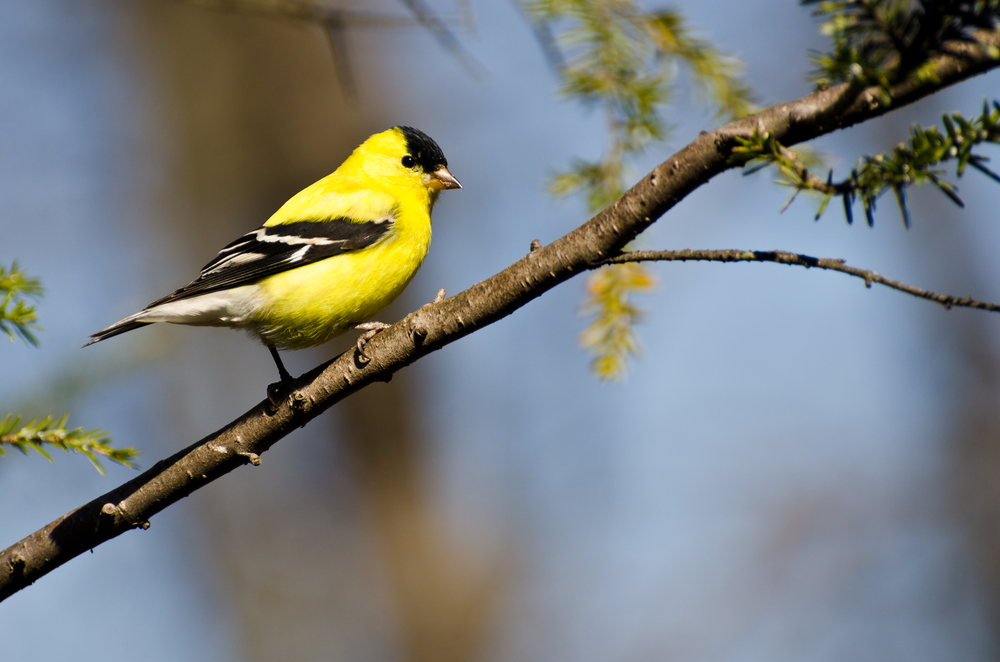
- Scientific Name: Spinus tristis
- Length: 11-15 cm
- Weight: 11–20 grams
- Wingspan: 19–22 cm
The striking and relatively common American goldfinch is excellent for beginner birdwatchers.
Appearance
With a pop of yellow plumage and bold black wings, the male American goldfinch is easy to spot from a distance. Their wings have white bars and the tails have black and white stripes.
Females are characteristically more subtle with light brown bodies and black wings but have a dusting of yellow on their throats.
Range
They crop up in Florida during non-breeding seasons, then flock up north to find a mate. Expect to see plenty of American goldfinches in Florida between December and January.
Diet
This is the finch you look for when you want an easy bird to snap photos of. American goldfinches are fond of feeders and love to munch on Nyjer and sunflower seeds.
They don’t eat any insects. Just make sure your feeders have designs meant for smaller birds since these little passerines are shy around bigger species.
Birdsong
I just love their birdcall, which is a complex song of tweets and trills interspersed with rapid-fire chirps.
Fun Fact
There are four subspecies of the American goldfinch – the eastern goldfinch, pale goldfinch, willow goldfinch, or northwestern goldfinch.
Pine Siskin

- Scientific Name: Carduelis pinus
- Length: 11 cm to 14 cm
- Weight: 12 grams to 18 grams
- Wingspan: 18 cm to 22 cm
Another finch that’s great to add to a beginner’s portfolio is the widespread pine siskin.
Appearance
Similar in coloration and size to the American goldfinch’s yellow feathers, male pine siskins are distinctive with heavily streaked bodies, wings, and tails. Their tail is also shorter with a sharp forked shape.
Females have fewer yellow patches than males, though they look similar at a glance.
Range
Pine siskins aren’t content to stay in one place, often traversing all over North America. They tend to show up in Northern Florida during the winter months.
Their environments are also quite diverse, showing up in vast fields and deciduous forests alike.
Diet
While these finches sometimes dine on insects and berries, you can attract a few pine siskins to your bird feeder with seeds.
Birdsong
Their birdcall is long and sweeping, often cresting upwards with a vibrating zweee that repeats.
Fun Fact
Pine siskins are rather fond of salt, which I’m sure many of my fellow Americans can relate to!
House Finch

- Scientific Name: Haemorhous mexicanus
- Length: 12 cm to 15 cm
- Weight: 21 grams
- Wingspan: 20 cm to 25 cm
You’ll need a sharp eye for the house finch, which may appear like a sparrow at a glance.
Appearance
Adult males are a subtle gray-brown with a light dusting of pale red on the head. However, their heads can sometimes appear yellow-orange or yellowish. Female house finches are light brown with brown and white flecked chests and stomachs.
Range
House finches are comfortable in both urban areas such as buildings and parks, but also make their home in rural locations. They often head south when migrating.
Diet
These birds are determined foragers, often digging around in the ground for flowers, insects, and seeds. You’ll regularly see them in heavy flocks in Florida, so try spotting them while out on a walk or attract them with your feeder with fresh seeds.
Birdsong
The birdsong of house finches is both warbling and repetitive, often rising with a two-then-one note pattern with a twee or whee-ut sound.
Fun Fact
House finches were originally brought to Long Island, New York by bird sellers who later decided to turn their catches loose. Flash forward a few decades and they’re now a common sight throughout the United States.
Cuban Bullfinch

- Scientific Name: Melopyrrha nigra
- Length: 15 cm
- Weight: 19 grams
- Wingspan: 25 cm
The Cuban bullfinch is an interesting addition to this list for many reasons, starting with the coloration of adult males.
Appearance
The first unique detail is its coloration – the males sport a bold black head with black all over and a distinctive white stripe on the curve of their wings. Female and juvenile Cuban bullfinches are more gray-black with a much smaller white stripe.
Range
The second unique detail is that these birds, well…live in Cuba! Since Cuba is just a hop and a skip beneath the Southern coast of Florida, they sometimes visit the Sunshine State.
They’re rather rare, though, so keep a sharp eye out in heavily forested areas.
Diet
They usually eat fruits and flower nectar, but you may be able to tempt them to your feeder with seeds.
Birdsong
Their birdcall has a noticeable trill to it and will often drop into sharp, thin chirps.
Fun Fact
The Cuban bullfinch shares a family with Darwin’s finches, a bird family that’s believed to have evolved from a single finch over a million years ago.
European Goldfinch

- Scientific Name: Carduelis carduelis
- Length: 12 cm to 13 cm
- Weight: 14 grams to 19 grams
- Wingspan: 21 cm to 25 cm
The European Goldfinch is easily one of my favorite finches for its brilliant coloration.
Appearance
The males have a bold red face, light brown body, and sharp yellow wing spots. Both their beaks and feet are a pale beige. Female European Goldfinches are very similar but with a smaller red spot and a slightly lighter belly.
Range
These birds are one of the most difficult to spot in Florida since they usually show up in the Midwest.
Diet
Determined birdwatchers may occasionally glimpse them at seed feeders in the winter. Just make sure to stock up on nyjer seeds.
Birdsong
Their birdsong is brilliantly complex, alternating between whistles, chirps, and warbling trills. Their chirps take on a distinctive pew-pew-pew pattern.
Fun Fact
As a painter, I just have to note the classical art roots of these stunning finches. These birds were regularly featured in paintings of the Madonna and Child during the Italian Renaissance, such as Madonna of the Goldfinch by Raphael.
Greater Antillean Bullfinch

- Scientific Name: Loxigilla violacea
- Length: 16.5 cm
- Weight: 22 grams
- Wingspan: 36 grams
Want to try and catch a glimpse of another country without leaving the country? The Greater Antillean Bullfinch’s stomping grounds hail from both The Bahamas and Jamaica – these vibrant origins are reflected in its striking coloration.
Appearance
Males have black bodies with red throats, undertail, and ‘eyebrows’. Females look similar but with less saturated color.
Range
Their preferred habitats are shrublands, subtropical forests, and moist lowlands.
Diet
These birds have a rather interesting diet of flowers, seeds, and snails.
Birdsong
They have buzzing and zipping birdcall with identifiable tzit-tzit sounds.
Fun Fact
While there are no official reports of these birds visiting Florida, it’s only a matter of time until they show up.
Evening Grosbeak
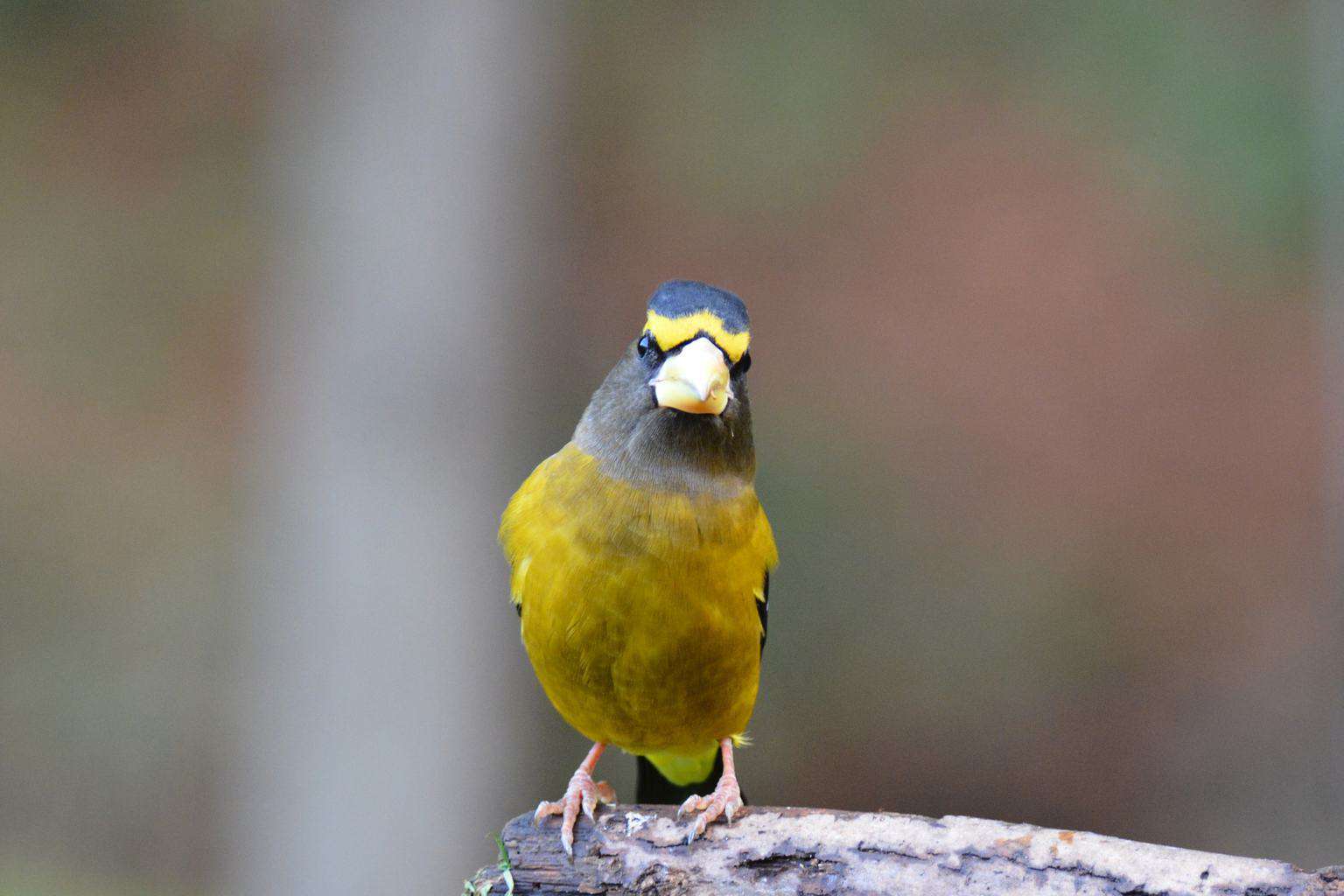
- Scientific Name: Hesperiphona vespertina
- Length: 16 cm to 22 cm
- Weight: 60 grams
- Wingspan: 36 cm
Appearance
The male Evening grosbeak boasts coloration not unlike a classic flan – their gray heads contrast their yellow bodies and black-tipped wings beautifully. They also bear a white patch on the sides of their wings with a pale beak.
Female evening grosbeaks differ greatly with light green-brown bodies, gray stomachs, and white wing spots. Their tails are very short and give them a distinctive ‘swooping’ silhouette.
Range
This finch loves to roam, often appearing in Northern America, but occasionally visiting Florida during migration.
Expect to glimpse them in the winter, but only with a hearty helping of patience. When they do arrive, you’ll notice they’re social birds and tend to have very large flocks.
Diet
They’re very fond of sunflower seeds, though they also eat berries and insects. Try attracting them to your backyard feeders with fresh seeds.
Birdsong
Their bird call has irregular rises and dips, sometimes in a series of two or three chirps.
Fun Fact
Their birdcall is sometimes confused for a house sparrow’s.
Rose-Breasted Grosbeak
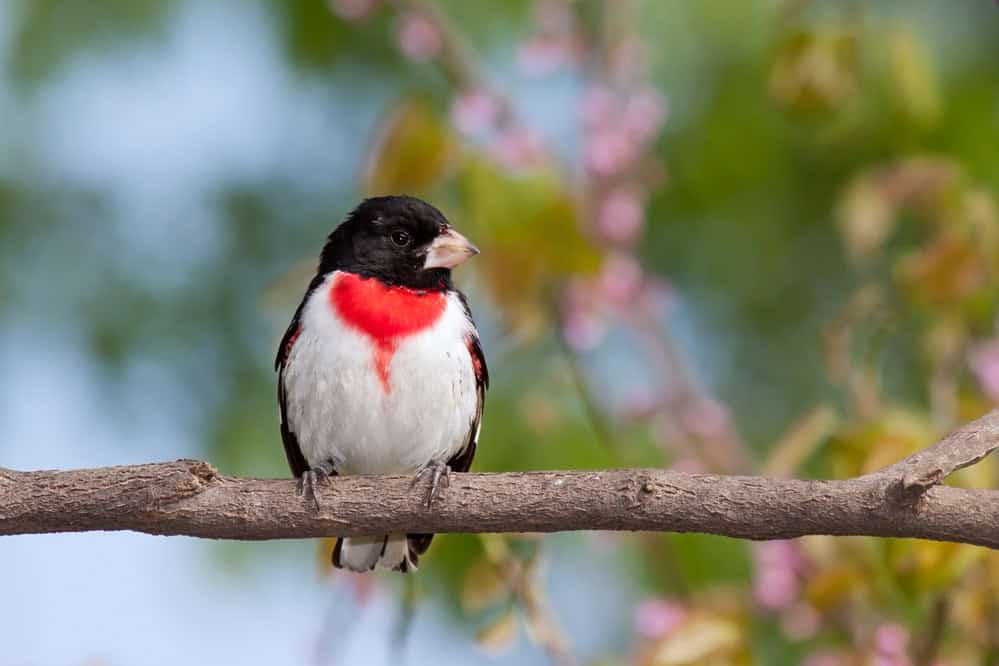
- Scientific Name: Pheucticus ludovicianus
- Length: 18 cm to 22 cm
- Weight: 35 grams
- Wingspan: 29 cm to 33 cm
This finch’s name is immediately obvious with its stunning red chest, widely considered to be one of the most beautiful birds around.
Appearance
The male finch has a bright red chest with a black body and white belly. The females look similar to a house sparrow with a spackled brown and white body with a white belly.
Range
Rose-breasted grosbeaks like to visit Florida while migrating, so make sure to time your birdwatching expeditions carefully. While they love deciduous forests, they prefer open, weedy fields during the winter months.
Diet
Their diet is quite diverse, often containing a mix of berries, insects, and nectar. Try outfitting your seed feeders with sunflower seeds, blackberries, or oats to attract them.
Birdsong
Their songs are soft and a little warbling, often sounding like a faint whistle in the distance.
Fun Fact
Their call can sometimes be confused for a woodpecker’s.
Blue Grosbeak

- Scientific Name: Passerina caerulea
- Length: 14 cm to 19 cm
- Weight: 26 to 31.5 grams
- Wingspan: 26 to 29 cm
Somehow subtle yet stunning, the Blue Grosbeak is a testament to how unique finches can look.
Appearance
The males have a dusty blue color with hints of brown peppered throughout their wings and back. Their gray bill and gray legs stand out almost as much as the black bands around their eyes.
Females have a light gray and brown body with black bars around their wings and gray conical bills.
Range
Blue grosbeaks show up in Northern Florida during breeding season and Southern Florida during migration. They often skirt the edges of forests as well as scrubs and thickets.
Diet
These finches love fruits, seeds, and snails. They prefer to forage on the ground rather than trees.
Birdsong
Blue grosbeaks have a lilting, warbling call with long pauses in between.
Fun Fact
Their scientific name includes the Latin word caerulea, which means sky blue or dark blue.
Florida Is a Paradise for Bird Lovers
Florida is a paradise in more ways than one. While you’re soaking up the sun, take some extra time to see if you can spot one of these dazzling finches.
Since a few of these finches are incidental to the country, you’ll need a little extra patience and a few tools to spot them. Consider stocking up your bird feeder with Nyjer seeds to attract indigo buntings or American goldfinches. If you’re lucky, you may even glimpse a Cuban bullfinch!
Want to learn more about the birdlife in the Sunshine State? We’ve got a guide on birds in Florida with your name on it!

